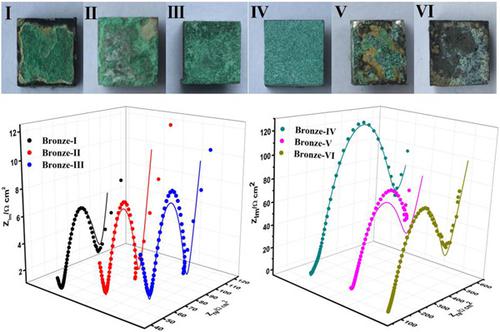当前位置:
X-MOL 学术
›
Mater. Corros.
›
论文详情
Our official English website, www.x-mol.net, welcomes your
feedback! (Note: you will need to create a separate account there.)
Corrosion behavior of Cu–Sn bronze alloys in simulated archeological soil media
Materials and Corrosion ( IF 1.6 ) Pub Date : 2019-12-16 , DOI: 10.1002/maco.201911338 Zhipeng Liang 1 , Kaixi Jiang 1, 2 , Tingan Zhang 1 , Zhihe Dou 1
Materials and Corrosion ( IF 1.6 ) Pub Date : 2019-12-16 , DOI: 10.1002/maco.201911338 Zhipeng Liang 1 , Kaixi Jiang 1, 2 , Tingan Zhang 1 , Zhihe Dou 1
Affiliation

|
The corrosion behavior of synthetic Cu–Sn bronze alloys with six different Sn contents was examined through an electrochemical test and a synthetic test in a simulated corrosive medium. The mechanism of corrosion and the morphology of the corroded surfaces were characterized through field emission scanning electron microscopy equipped with energy‐dispersive spectroscopy. At the corrosion potential, the corrosion behavior appears to be determined by the charge transfer step and the diffusion process. It was found that the bronze‐IV (Cu–26.8Sn) specimen exhibited the best corrosion resistance, as evidenced by a low corrosion current density and a high impedance. This improvement resulted from an increase in the content of the Cu–Sn solid solution in the alloy, which was conducive to forming a relatively more protective passive film on the surface of the bronze alloy. This finding would be valuable in the anticorrosion protection of archeological artefacts after their excavation.
中文翻译:

Cu-Sn青铜合金在模拟考古土壤介质中的腐蚀行为
通过电化学测试和在模拟腐蚀性介质中的合成测试,对六种不同锡含量的合成Cu-Sn青铜合金的腐蚀行为进行了检查。通过配备能谱仪的场发射扫描电子显微镜对腐蚀的机理和腐蚀表面的形态进行了表征。在腐蚀电位下,腐蚀行为似乎由电荷转移步骤和扩散过程决定。结果发现,青铜-IV(Cu-26.8Sn)样品表现出最佳的耐腐蚀性,这表现为低腐蚀电流密度和高阻抗。这种改善是由于合金中Cu-Sn固溶体含量的增加,这有利于在青铜合金的表面上形成相对更具保护性的钝化膜。这一发现对考古文物开挖后的防腐蚀保护具有重要意义。
更新日期:2019-12-16
中文翻译:

Cu-Sn青铜合金在模拟考古土壤介质中的腐蚀行为
通过电化学测试和在模拟腐蚀性介质中的合成测试,对六种不同锡含量的合成Cu-Sn青铜合金的腐蚀行为进行了检查。通过配备能谱仪的场发射扫描电子显微镜对腐蚀的机理和腐蚀表面的形态进行了表征。在腐蚀电位下,腐蚀行为似乎由电荷转移步骤和扩散过程决定。结果发现,青铜-IV(Cu-26.8Sn)样品表现出最佳的耐腐蚀性,这表现为低腐蚀电流密度和高阻抗。这种改善是由于合金中Cu-Sn固溶体含量的增加,这有利于在青铜合金的表面上形成相对更具保护性的钝化膜。这一发现对考古文物开挖后的防腐蚀保护具有重要意义。











































 京公网安备 11010802027423号
京公网安备 11010802027423号